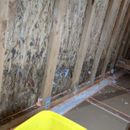I was working on sealing all ceiling penetrations in the attic when I noticed that there is mold on the north side of the sheathing. Majority of it is concentrated below the blown in insulation line, but there are a few tiny spots above it as well. There are no other major spots of mold in the attic. So far I have washed the moldy OSB with soapy water and let it to dry.
I am thinking about applying 1″ ridgid foam between the framing, leaving air gap between foam and sheathing and then using spray foam on sides and the bottom, but not the top. This way sheathing will not come in contact with the blown-in insulation and it will be able to breathe. Is that a good idea? Is there a better solution.
I am located in IL (zone 5A), attic uses ridge venting. Two bathroom fans are using soffit vent, but they are located midway between north/south side of the house and there is no mold in the area where they vent.
Thanks.










Replies
Pictures: https://imgur.com/a/YYv6Ekw
Fluffy,
The mold is appearing at the very bottom of the gable wall sheathing, above the top plate of the exterior wall. This is a classic sign of air leakage through your exterior wall. Warm, moist interior air was entering your exterior wall at the electrical outlets, and escaping from the wall through cracks near the top plate. The moisture in the interior air then condensed on the cold sheathing of the gable wall.
It's clear that you have recently foamed the crack through which the air was exfiltrating. This should stop future moisture accumulation.
Cleaning up the mold isn't very important, as long as you have corrected the moisture problem (and I think you have). This mold won't hurt your family. I would replace the missing insulation without further worries.
Note that some soaps are food for mold (I learned this the hard way). Some detergents (like Borax) kill mold.
Be sure to verify any air sealing and moisture reduction (don't count on looks). If you have continuing problems, consider an inch of two part closed cell spray foam over the entire area.
You can clean the mold with a bleach solution and a brush. There is a lot of info out there for small-scale mold remediation like this. Wear a respirator while doing it.
I’ve had a very similar problem to yours in my own house on the underside of the roof sheathing in a few spots. As others have mentioned, now that you’ve sealed up the air leaks the mold growth should stop. If you clean the existing mold, you can watch the area over the season to see if there is any new growth. You’ll probably find that the air sealing will solve the problem.
Bill
Thanks a lot for quick replies guys. In cases like these is there also a risk that mold will develop inside the exterior wall from where warm air was entering? Wall is using 2x4 framing and insulated with fiberglass insulation batts.
Thanks again!
Fluffy,
Q. "Is there also a risk that mold will develop inside the exterior wall from where warm air was entering?"
A. Yes. The greater attention you pay to air sealing efforts, the less the chance that mold will grow. In a cold climate, the more air leaks in a wall, the greater the chance that the sheathing will be damp.
Once you reduce the rate of air leaks through the wall, I wouldn't worry about the mold. It will be an inactive stain, and in any case its existence won't hurt you.
Deleted
Is the photo of the gable end wall of the house? The angles do not look like 90°in the photo making me wonder if you have gambrel roof.
Do you have more square inches soffit vent than ridge vent?
Please take a few minutes the watch Lstiburek’s video
https://www.greenbuildingadvisor.com/article/lstibureks-rules-for-venting-roofs
Walta